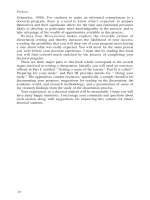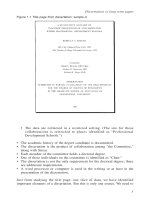Writing your doctoral dissertation - part 1 docx
Bạn đang xem bản rút gọn của tài liệu. Xem và tải ngay bản đầy đủ của tài liệu tại đây (146.41 KB, 5 trang )
xi
Preface
For the past twenty-five years I have been working with doctoral students,
guiding their evolution to doctoral recipients. During the time we work
together, I become intensely conscious of their need to understand the culture
of the university as it impacts on their progress. Concurrently, they need to
be receptive to engaging in a transformative, life-changing experience, the
essence of learning. As I recall my own days as a doctoral student, I
remember being at a total loss to understand what was happening to me. I
have discovered this is not unique. Most have no idea what a dissertation
looks like or how it evolves.
While most doctoral students expect to draw on their earlier collegiate
experiences, nothing in the academic world prepares them for the complexity
and intensity inherent in the doctoral process. I have identified the crucial
issues to include in Writing Your Dissertation: Invisible Rules for Success
from multiple sources:
• my experience in guiding more than seventy-five doctoral dissertations to
completion;
• more than 200 anonymous responses by doctoral students and graduates
to open-ended questionnaires;
• focus groups with doctoral students and graduates; and
• informal conversations with current doctoral students and graduates,
including some of whom teach in doctoral programs across the nation.
Increasing numbers of adults are receiving doctoral degrees (Magner, 1999),
but it is a culture in which most admit a lack of knowledge of the rules. They
frequently search for explicit information about what this complex, highly
interactive, academic, social, and political process involves. Access to
knowledgeable sources of information is limited, yet essential for emotional
and intellectual survival. This book serves as a practical guide for students to
progress in planning, writing, and defending their dissertations.
When students seek to understand the rules of the program, they are
frequently referred to the university Bulletin or told to see their advisor. There
is little explicit documentation of what occurs in a doctoral program. What is
particularly missing from these sources is information about the human
Preface
xii
element, the social interactions which are the hallmark of doctoral programs,
and probably the most problematic for most doctoral students. Recognizing
the need to address this gap, I have developed a comprehensive guide to many
dimensions of the doctoral process, particularly focusing on the writing of
the doctoral dissertation.
While the primary goal in writing this book is to help current doctoral
students to survive and flourish in their programs, I have also become aware
of the need to consider major reforms in the doctoral process. This has been
supported by recent publications (e.g.: Kennedy, 1997; Lovitts, 1996;
Menand, 1996; Olson and Drew, 1998). For current enrollees, survival is
probably the key issue, but from a long-term perspective, I think we in the
academic world need to reflect on what is expected of students, and find ways
to create more supportive settings for students and the academic community-
at-large. While the primary audience for Writing your Doctoral Dissertation
is current students, doctoral students may find it productive to share this book
with friends and relatives, helping them to understand and provide more
supportive settings in completing a dissertation. In addition, graduates have
impressed me with their desire, now that they are done, to compare their
experiences with others, as well as to obtain a clearer sense of the totality of
the experience. Certainly faculty would benefit from understanding the
students’ perspectives as well.
Each academic institution creates unique rules and procedures for
completing a doctoral degree, but there are many similarities across
institutions. Writing your Doctoral Dissertation offers a combination of the
general rules, along with strategies for coping with the range of experiences
you may encounter in your progress. The book will prepare you for some of
the likely hurdles, offering guidance to avoiding conflicts, and to working
through problems which are impossible to predict but will inevitably occur. I
frequently remind you to “check with your advisor,” “check with your peer-
support group,” “check with your chair.” These individuals know your local
terrain. The more information you have, the more prepared you will be to
address each of the issues in your program and to handle your unique
experiences.
A case could be made that doctoral students are required to be the most
rigorous researchers. Researchers are resourceful, seeking information in a
wide array of sites. As a reader of this book, you are a researcher. Writing
your Doctoral Dissertation supplements any materials available at your
institution. It cannot supplant any institutional documents or explanatory
requirements. Read all publications from your institution which enumerate
the steps in the process, as well as any academic calendars which might offer
clues about mandated activities (e.g. preliminary examinations, matriculation
interviews, oral defenses) and their frequency of occurrence (e.g. once each
semester, annually). The Bulletin is a good starting point, but don’t stop there.
Look for brochures, pamphlets, fliers, bulletin board notices, advertisements
in campus newspapers, and program newsletters. Explore the materials
available in the Graduate Office and the Office of the Dean of Graduate
Preface
xiii
Studies, or like, which might describe some of the requirements. Inquire
about program meetings, informal gatherings, and advisement materials
which may offer a map of what to expect.
To obtain the information contained in these pages, I have engaged in
intensive research, obtaining numerous lenses on this phenomenon which we
call “going for my doctorate.” Some 250 people provided information on
their own experiences as doctoral students and doctoral advisors. Within the
text, and as epigraphs at the beginning of chapters, you will see direct
quotations from these sources. For more information about my research
procedures, see Brause (1997) and Appendix A. A critique of the doctoral
process based on this research is in preparation.
While there are increasing numbers of books which are outlining the parts
of a dissertation (see Appendix B for some useful titles), there is a need for
students to understand both the academic and the social elements which
contribute to their progress. This book combines both of these elements as it
provides step-by-step guidance in moving from identifying a research
problem to defending your dissertation. Most students in doctoral programs
proceed through the steps with only a vague understanding of what a
dissertation is or what is involved in getting one. Having a sense of typical
issues, you will be ready for what lies ahead for you.
This book will probably be useful to read in two ways:
• first, as a quick read—offering an overview of “the terrain” and an
explanation of all the steps in the process of writing a dissertation;
• second, as ready reference—providing a step-by-step guide to creating
your committee, writing your proposal, and preparing for your oral
defense, for example.
I expect that you will initially review the total contents, noting the range of
information, realizing the impossibility of attending to all the details, but
happy to know that they are available for later reference. Recognizing the
depth of detail provided, you will intelligently read carefully up to the point
where you are in writing your dissertation. Then, you will read the next
chapter v-e-r-y s-l-o-w-l-y. You will refer to each chapter in turn, as you
progress through your research apprenticeship. (This assumption follows
from Gail Sheehy (1976)’s experience with Passages: Predictable Crises of
Adult Life, in which people tended to read to the chapter which represented
their current stage, and deferred reading subsequent chapters until the time
when they were at that next stage.) Each person will start this intense reading
at a different place, eventually proceeding to the final chapters as you triumph
in writing your doctoral dissertation. I am writing this book as a student
advocate. I acknowledge there are numerous, significant problems in the
process, many of which were highlighted in the process of collecting the data
for this book. The most notable event was the recent suicide of a doctoral
student which was attributed to university procedures that isolated students
and made them vulnerable to the whims of one faculty member (see









